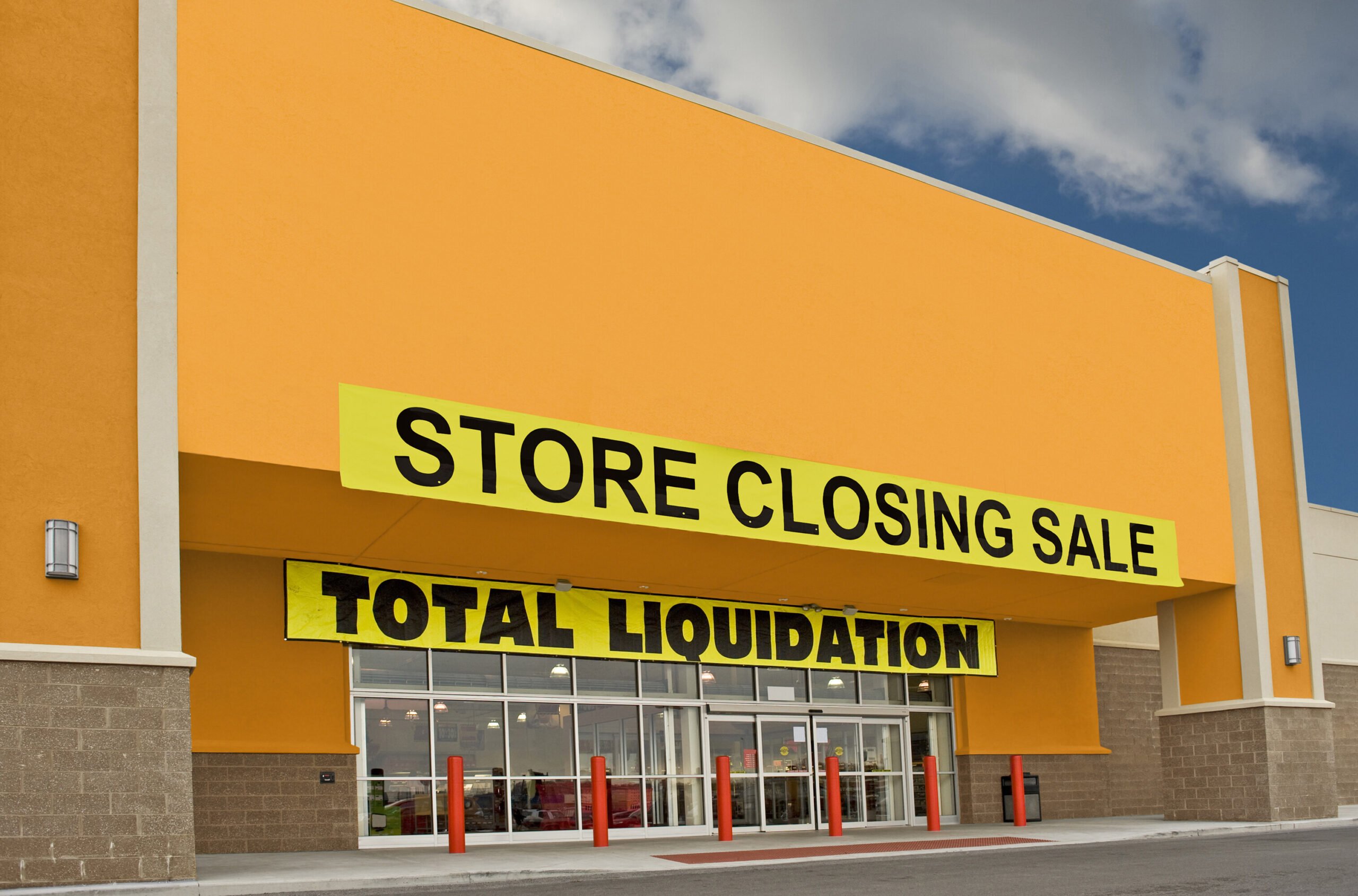
9 Examples of Why Businesses Fail
If you want to know why businesses fail in a time with so many resources available, this article will explore why it’s important for small business owners to become familiar with the internet. As we look into the decline of 9 American empires, ask yourself “What if?” What if this company took advantage of the power of the internet instead of letting it become a tsunami and being pummeled by it? Many business owners that I talk to, are complacent and satisfied with their current position. Unbeknownst to them, everything is in a constant state of change. In the world of business today, everything only moves faster. If you’re not ahead of the next wave, you are sure to become washed away by it.
The businesses we are going to see on this list aren’t small ones, they were symbols of wealth and success for many years. And though they seemed to stand the test of time, it was their own doing that led to their demise.
1. Sears
Sears never changed with the times. If you walk into a remaining store today, you will be reminded of a department store from the 1980’s. The stores were not even kept up or clean, making the customer experience inside of them not a pleasant one. Poor management practices and resting on their laurels’ eventually ended this American icon after 125 years in business! One bankruptcy expert described Sears’ downfall as “the slowest-moving train wreck.” It’s a real shame, Sears should have become Amazon back in 1991, when the World Wide Web became publicly available. That would have taken this company into the future. What is left of this American icon is only a lesson to all businesses, and that is: You Must Change.
2. KMART
Over the last decade, KMART has closed over 2/3 of its stores. In the 1970’s, KMART was on their game. This company was founded in 1899 by Sebastian Spering Kresge. by 1912, S.S. Kresge had 85 stores and an annual sales of over $10 million. The company went public in 1918 and in 1962, a variety store opened as the first KMART. By 1966, KMART had grown to 162 stores, and the annual sales numbers soared over $1 billion! By the 1970’s KMART was opening a new store every week and continued to grow, that by 1995, they had over 2000 stores and an annual sales of $34 billion.
In 1962, two other companies opened that year, but they had a different business strategy. Both Walmart and Target were able to do more with less stores. By the 1980’s, these two competitors started to move into KMART’s established areas. That led to the beginning of the end for KMART. Poor leadership and management only added nails to their coffin. KMART merged with Sears in 2005, and well…you can see why they never had a chance. I wonder what would have happened if KMART would have dominated the internet when they had their opportunity? Do you think that bankruptcy would have even been on their radar?
3. Toys R US
Gary Vaynerchuk, or as so many calls him “GaryVee,” is one of my favorite business coaches. His passion for Toys R Us comes to life in these videos as he talks about the decline of a super-giant. Take note as he explains why a huge company with such a long history failed when they should have used the power of the internet to their favor. I meet a lot of small business owners who have the same mentality almost every day. What these poor unsuspecting people don’t realize is that by avoiding to learn the power of the internet, they are actually signing their own death sentence.
4. Blockbuster Video
Blockbuster Video was a chain of video rental stores based in the United States, but with locations all around the world. David Cook started this massive video empire from a small video store in Dallas, Texas in October of 1985. In 1987, David sold a large portion of his company to an investment group and left the company. A massive expansion of stores ensued after the departure of David Cook. By 2004, there were over 9000 locations and over 84,000 employees worldwide! This was no small business anymore.
Sweet Irony
In 1997 a Blockbuster customer, Reed Hastings, received a $40 late fee after returning the movie Apollo 13 late. Later, he would use his anger and frustration as fuel to create his new company that became NETFLIX. This would become the beginning of the end for Blockbuster Video, not because they couldn’t handle the competition, but because they couldn’t see past their moment of glory. NETFLIX launched April 14, 1998 as a pay-for-rent model (like Blockbuster), but through the mail. An individual would pay one flat fee with unlimited rentals without due dates or late fees. In 2000, NETFLIX was offered to Blockbuster for $50 million, and was turned away. At the time, Blockbuster was making $800 million in late fees alone. But this bad decision cost the company more than it could recover from, and eventually became its demise.
Today, Hastings is worth somewhere in the area of $3.7 billion…and his company is still running strong.
5. Montgomery Ward
This company started in 1872 as a catalog company. Like Sears, they eventually opened stores across the country and around the world. Their strategy was to open department stores in rural America and they eventually ended up in every major mall. Most people can remember Montgomery Ward at one end of their local mall. in 1985, the catalog company would shut down and the company would focus more on their store chains. “Electric Avenue” became a big hit in the late 1980’s and 1990’s, but like Sears, Wards didn’t put much effort into the internet either.
They were innovative in their early beginnings, but somewhere along the line, the need to stay with the current trends just wasn’t that important to them anymore. Big companies like Montgomery Ward going out of business after a long history at the top should open the eyes of any small business that thinks their time above water will guarantee another year in business.
The Titanic was a ship built so big and strong it was said to be “unsinkable.” As the remains of that unsinkable ship sits on the floor of the Atlantic, one can only observe the level of foolishness in that mentality.
6. RadioShack
Two brothers in Boston Massachusetts started Radio Shack back in 1921. A series of serious decision blunders led to their demise. Of course, the biggest mistake they could have made was the same one every company on this list made, which was, they didn’t see the importance of exploring their online options. However the poor management decisions that led to severe repercussions were also things like how close their stores were to each other, instability in their leadership, and financial missteps. In February 2015, RadioShack filed for bankruptcy.
7. Kodac
Kodac was founded by George Eastman, a bank clerk in Rochester, New York in 1883. With a chemistry background, George was interested in solving a problem. During his time, photography was difficult. Cameras were cumbersome, and prints were not easily made. Eastman invented rolled film and then a easy to use camera a few years later. This Idea sparked an entire industry… Mass Market Consumer Photography. Kodac managed to stay on top well over a century.
Since Kodac depended largely on film and prints for the bulk of their profits, they never invested much thought into making a better camera. When digital cameras came on the market in 1995, their problems began to become much more serious. By 2003 digital cameras surpassed film cameras in sales, and by 2010 the film camera market was on its back.
Bitter Irony
Kodac actually invented the digital camera in 1975, and introduced the first digital camera for consumers in 1995. Their prices were fair, but the quality of their camera wasn’t where it should have been for a company that started it all. Image sharing was also an area of weakness for Kodac. In the digital age, these areas are crucial for a company’s survival. Kodac never understood how to adapt to the new online world and how much it could help or hurt their business. One would think reasonably that after eight consecutive years of operating losses, someone in their control tower would decide to hire an internet expert… no one did. Today, every cell phone comes with a built-in digital camera. What if every one of those cameras was a Kodac?
8. Nokia
This company dates back to 1865 in southern Finland as a small wood pulp mill. Fredrik Idestam was the founder, and with the help of his friend, Leo Mechelin, the two transformed the small business into Nokia. Through the 19th century the company grew and branched off into several different products (rubber, cables, tires, Televisions, etc.). During the Cold War era, The Finnish government wanted military research on radio telephone communications, and Nokia won the contract. From there, they evolved into a civilian car telephone network and took over the country by the 1970’s and expanded globally by 1985.
Nokia was a leader in mobile phones. In 1992, they had strong leadership that took them into their peak all through out the 1990’s. The decision to shut down everything and focus only on mobile phones would sculpt their success for over a decade. The Nokia 2110 was one of the first phones to send and receive text messages. After another change in management, the company started to move backwards. Internal conflicts and failed decisions and indecision in a fast-paced industry eventually ended this company’s amazing run.
9. Woolworth
I saved the best story for last because this one actually has a silver lining. Woolworth’s story starts in 1878. Frank Winfield Woolworth was the guy who had the brilliant hair-brained ideas. He worked in a retail store that tried to move some unwanted items quickly. Selling everything off for a nickel seemed to do the trick. Woolworth took notice and the idea of the five and dime store was realized. He borrowed $300 from his former employer and took his idea to New York and failed. But that didn’t stop him from trying it again in another market. This time in Pennsylvania, the idea took off. Soon he was opening new stores and hiring friends and family to help him run the new locations. By the 1960’s Woolworth was bringing in over $1 billion in annual sales!
But by this time, department stores were the next big thing. So, in 1962, to roll with the times, they started a chain of stores called Woolco. This was the same year that KMART, Walmart and Target started as well. They weren’t unique enough to compete with that much competition.
Something to Learn from Woolco
This is a prime example of why it’s important to be a step ahead of your competition in your industry. A great marketing campaign around something unique about your business can and will put your company on the top of its industry and ahead of the competition. When everyone else is ordinary, you should be extraordinary! In the business world today, you need this kind of strategy.
The Silver Lining
Although all of the Woolworth/ Woolco stores closed down in the United States, the company is still alive and well for the moment…as Foot Locker. During the late 1960’s they purchased Kinney Shoes to stock their stores with these items. As it turned out, that one decision may have saved their neck from the reapers blade!
Take note, that all of these failed businesses had the financial resources to avoid their own demise. They felt that the Internet wasn’t going to have any effect on their unsinkable ship. To their dismay, it did and their memory should be a lesson for all businesses who want to continue into the future. You can’t keep doing things the way you did 30 years ago. Your competition may be in diapers now, but in a year or two they will be throwing dirt on your coffin…if you let them.
Change is the only sure thing you can ever count on, because it’s a law of nature. Everything is in a constant state of change. If you are a business owner, you really need to stay informed about what is happening next. If your mindset is that you like things just the way they are now, then let this article be your wake-up call. The lesson here is simply this: “Move with innovation and don’t let pride cloud your judgement.” Sometimes a business coach is a much better investment than merely throwing money into the abyss of blind advertising. Click here to learn more about why a business coach is a good idea.



